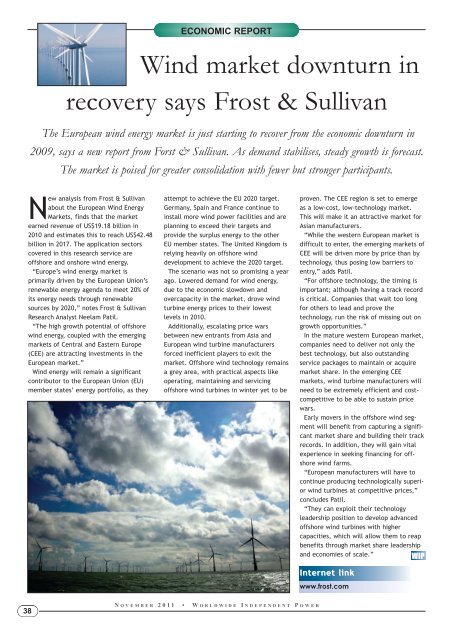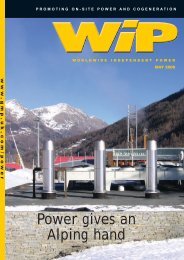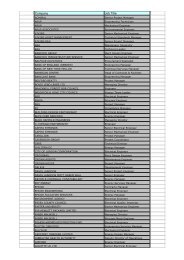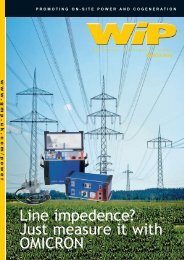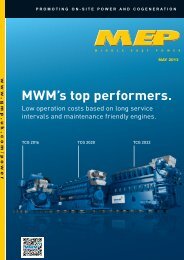FREE ENTRY - Global Media Publishing Ltd. - UK.COM
FREE ENTRY - Global Media Publishing Ltd. - UK.COM
FREE ENTRY - Global Media Publishing Ltd. - UK.COM
Create successful ePaper yourself
Turn your PDF publications into a flip-book with our unique Google optimized e-Paper software.
New analysis from Frost & Sullivan<br />
about the European Wind Energy<br />
Markets, finds that the market<br />
earned revenue of US$19.18 billion in<br />
2010 and estimates this to reach US$42.48<br />
billion in 2017. The application sectors<br />
covered in this research service are<br />
offshore and onshore wind energy.<br />
“Europe’s wind energy market is<br />
primarily driven by the European Union’s<br />
renewable energy agenda to meet 20% of<br />
its energy needs through renewable<br />
sources by 2020,” notes Frost & Sullivan<br />
Research Analyst Neelam Patil.<br />
“The high growth potential of offshore<br />
wind energy, coupled with the emerging<br />
markets of Central and Eastern Europe<br />
(CEE) are attracting investments in the<br />
European market.”<br />
Wind energy will remain a significant<br />
contributor to the European Union (EU)<br />
member states’ energy portfolio, as they<br />
38<br />
ECONOMIC REPORT<br />
Wind market downturn in<br />
recovery says Frost & Sullivan<br />
The European wind energy market is just starting to recover from the economic downturn in<br />
2009, says a new report from Forst & Sullivan. As demand stabilises, steady growth is forecast.<br />
The market is poised for greater consolidation with fewer but stronger participants.<br />
attempt to achieve the EU 2020 target.<br />
Germany, Spain and France continue to<br />
install more wind power facilities and are<br />
planning to exceed their targets and<br />
provide the surplus energy to the other<br />
EU member states. The United Kingdom is<br />
relying heavily on offshore wind<br />
development to achieve the 2020 target.<br />
The scenario was not so promising a year<br />
ago. Lowered demand for wind energy,<br />
due to the economic slowdown and<br />
overcapacity in the market, drove wind<br />
turbine energy prices to their lowest<br />
levels in 2010.<br />
Additionally, escalating price wars<br />
between new entrants from Asia and<br />
European wind turbine manufacturers<br />
forced inefficient players to exit the<br />
market. Offshore wind technology remains<br />
a grey area, with practical aspects like<br />
operating, maintaining and servicing<br />
offshore wind turbines in winter yet to be<br />
N OVEMBER 2011 • WORLDWIDE I NDEPENDENT P OWER<br />
proven. The CEE region is set to emerge<br />
as a low-cost, low-technology market.<br />
This will make it an attractive market for<br />
Asian manufacturers.<br />
“While the western European market is<br />
difficult to enter, the emerging markets of<br />
CEE will be driven more by price than by<br />
technology, thus posing low barriers to<br />
entry,” adds Patil.<br />
“For offshore technology, the timing is<br />
important; although having a track record<br />
is critical. Companies that wait too long<br />
for others to lead and prove the<br />
technology, run the risk of missing out on<br />
growth opportunities.”<br />
In the mature western European market,<br />
companies need to deliver not only the<br />
best technology, but also outstanding<br />
service packages to maintain or acquire<br />
market share. In the emerging CEE<br />
markets, wind turbine manufacturers will<br />
need to be extremely efficient and costcompetitive<br />
to be able to sustain price<br />
wars.<br />
Early movers in the offshore wind segment<br />
will benefit from capturing a significant<br />
market share and building their track<br />
records. In addition, they will gain vital<br />
experience in seeking financing for offshore<br />
wind farms.<br />
“European manufacturers will have to<br />
continue producing technologically superior<br />
wind turbines at competitive prices,”<br />
concludes Patil.<br />
“They can exploit their technology<br />
leadership position to develop advanced<br />
offshore wind turbines with higher<br />
capacities, which will allow them to reap<br />
benefits through market share leadership<br />
and economies of scale.”<br />
WIP<br />
Internet link<br />
www.frost.com


